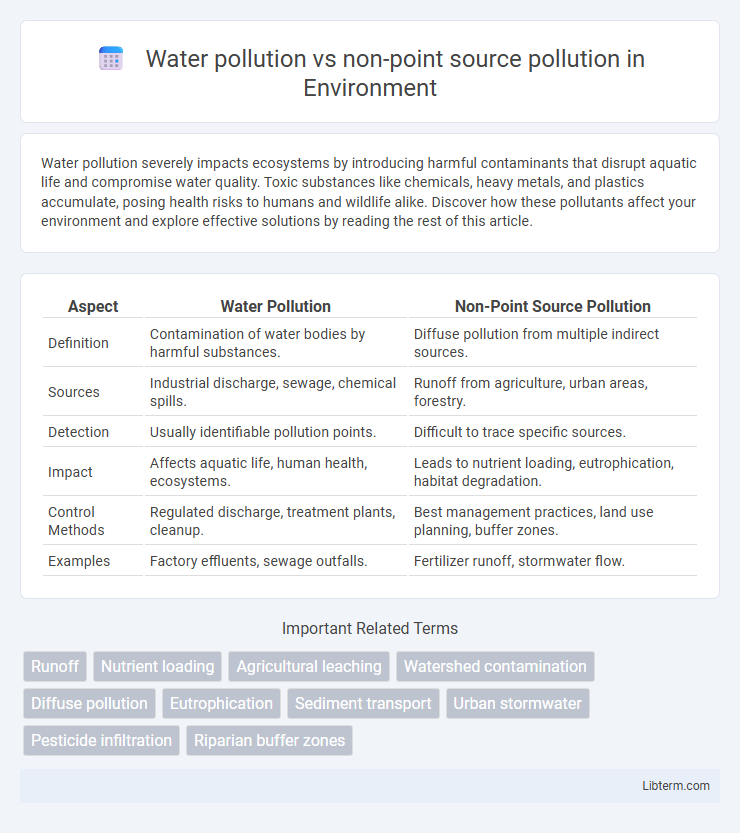Water pollution severely impacts ecosystems by introducing harmful contaminants that disrupt aquatic life and compromise water quality. Toxic substances like chemicals, heavy metals, and plastics accumulate, posing health risks to humans and wildlife alike. Discover how these pollutants affect your environment and explore effective solutions by reading the rest of this article.
Table of Comparison
| Aspect | Water Pollution | Non-Point Source Pollution |
|---|---|---|
| Definition | Contamination of water bodies by harmful substances. | Diffuse pollution from multiple indirect sources. |
| Sources | Industrial discharge, sewage, chemical spills. | Runoff from agriculture, urban areas, forestry. |
| Detection | Usually identifiable pollution points. | Difficult to trace specific sources. |
| Impact | Affects aquatic life, human health, ecosystems. | Leads to nutrient loading, eutrophication, habitat degradation. |
| Control Methods | Regulated discharge, treatment plants, cleanup. | Best management practices, land use planning, buffer zones. |
| Examples | Factory effluents, sewage outfalls. | Fertilizer runoff, stormwater flow. |
Understanding Water Pollution: An Overview
Water pollution encompasses contaminants entering water bodies from various sources, with non-point source pollution representing diffuse origins such as agricultural runoff, urban stormwater, and atmospheric deposition. This type of pollution is challenging to control due to its scattered nature, contributing nutrients, pesticides, sediments, and pathogens that degrade water quality. Understanding water pollution requires analyzing both point sources, like industrial discharges, and non-point sources, which significantly impact aquatic ecosystems and human health globally.
Defining Non-Point Source Pollution
Non-point source pollution refers to diffuse contamination that does not originate from a single, identifiable source, unlike point source pollution which comes from specific locations such as factories or sewage treatment plants. This type of pollution occurs when rainfall or snowmelt moves over and through the ground, picking up natural and human-made pollutants like fertilizers, pesticides, oil, and sediment. Non-point source pollution is a major contributor to water quality degradation, affecting rivers, lakes, and coastal waters by introducing excess nutrients and toxic substances.
Key Differences: Point Source vs Non-Point Source Pollution
Point source pollution originates from a single, identifiable source such as a factory discharge pipe or sewage treatment plant, allowing for easier regulation and control. Non-point source pollution comes from diffuse origins like agricultural runoff, urban stormwater, and atmospheric deposition, making it challenging to monitor and manage due to its widespread nature. Understanding these distinctions is crucial for developing targeted water quality management strategies and regulatory policies.
Common Causes of Non-Point Source Water Pollution
Non-point source water pollution primarily originates from diffuse sources such as agricultural runoff, urban stormwater, and sediment from construction sites. Common causes include fertilizers, pesticides, and animal waste washing into waterways, leading to nutrient pollution and harmful algal blooms. Unlike point source pollution, non-point sources are harder to control due to their widespread and variable nature across landscapes.
Agricultural Runoff: A Major Non-Point Source Contributor
Agricultural runoff is a leading cause of non-point source pollution, introducing excess nutrients, pesticides, and sediments into water bodies and significantly degrading water quality. Unlike point source pollution, which originates from identifiable locations such as factories or wastewater treatment plants, non-point source pollution is diffuse and difficult to regulate, making agricultural runoff a persistent environmental challenge. The elevated levels of nitrogen and phosphorus from fertilizers stimulate harmful algal blooms, oxygen depletion, and damage aquatic ecosystems, posing severe risks to public health and biodiversity.
Urban Runoff and Its Impact on Water Quality
Urban runoff, a major form of non-point source pollution, significantly degrades water quality by carrying contaminants such as oils, heavy metals, and nutrients from impervious surfaces into water bodies. This diffuse pollution source contrasts with point source pollution, which originates from identifiable discharge points like factories or sewage treatment plants. Managing urban runoff through green infrastructure and improved stormwater systems is critical to mitigating its harmful effects on aquatic ecosystems and public health.
Effects of Non-Point Source Pollution on Ecosystems
Non-point source pollution, primarily caused by agricultural runoff, urban stormwater, and atmospheric deposition, introduces excessive nutrients, sediments, and toxic chemicals into aquatic ecosystems, leading to eutrophication, habitat degradation, and loss of biodiversity. Unlike point source pollution, which is easier to monitor and regulate, non-point source pollution disperses pollutants over large areas, making its impact on water quality and aquatic life more persistent and widespread. The accumulation of pollutants from non-point sources disrupts food chains, reduces oxygen levels, and alters reproductive cycles, severely impairing ecosystem health and resilience.
Monitoring and Measuring Non-Point Source Pollution
Monitoring and measuring non-point source pollution involves advanced techniques such as remote sensing, geographic information systems (GIS), and watershed modeling to accurately assess pollutant loads across diffuse landscapes. Unlike point source pollution, which originates from identifiable locations, non-point source pollution requires comprehensive data collection on land use, rainfall patterns, and runoff dynamics to track contaminants like nutrients, sediments, and pesticides. Effective monitoring integrates field sampling with technological tools to generate spatially explicit data critical for managing water quality and implementing targeted remediation strategies.
Strategies for Reducing Non-Point Source Water Pollution
Implementing best management practices (BMPs) such as buffer strips, cover crops, and retention basins significantly reduces non-point source water pollution by minimizing runoff and sediment deposition. Urban stormwater management techniques including permeable pavements and green infrastructure also help filter pollutants before they enter water bodies. Public education programs and stricter land-use regulations further enhance efforts to control diffuse pollutant sources impacting water quality.
Policy Approaches for Managing Non-Point Source Pollution
Policy approaches for managing non-point source (NPS) water pollution emphasize watershed-based strategies and best management practices (BMPs) tailored to specific land uses such as agriculture and urban runoff. Regulatory frameworks include incentive programs, technical assistance, and cost-sharing mechanisms to encourage voluntary implementation of BMPs like buffer strips, nutrient management, and stormwater controls. Monitoring and adaptive management enhance policy effectiveness by identifying pollution hotspots and guiding resource allocation for continuous improvement.
Water pollution Infographic

 libterm.com
libterm.com